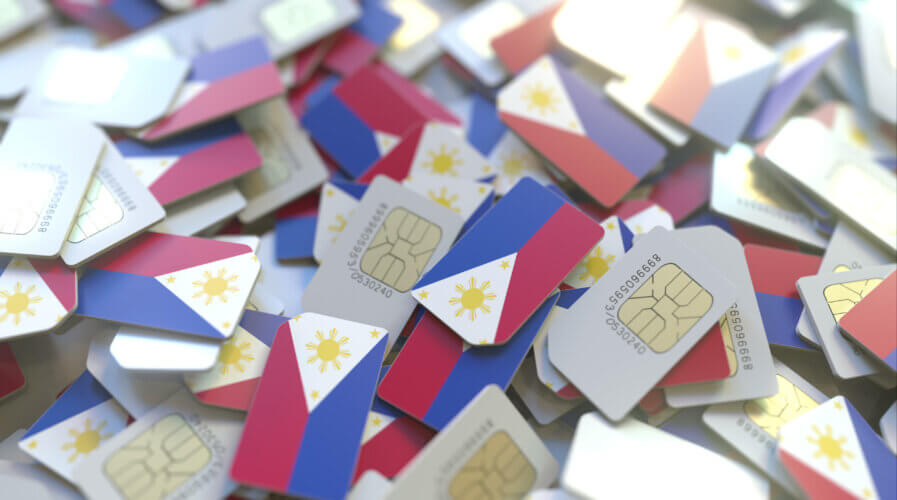
Here’s how a company like Globe is advancing 5G and e-wallet adoption in the Philippines.Source: Shutterstock.
Here’s how Globe is advancing 5G and e-wallet adoption in the Philippines
- Tech Wire Asia spoke to Ernest Cu, the President & CEO of Globe Group, discussing how the company is at the forefront of 5G network rollouts in the Philippines.
- Cu shared how Globe continues to expand its non-telco initiatives with a growing portfolio of digital companies, leading to record-high non-telco revenues.
In Asia, the 5G rollout has been proliferating. According to US networking giant Cisco, India, the Philippines, and Japan, will be at the forefront of 5G network rollouts this year. Taking a closer look at the Philippines, although 5G remains a small fraction of the total user base, the take-up rate has been increasing in recent years, with Globe Telecom, a major provider of telecommunication services in the country, being at the forefront.
To give an idea of how Globe is driving the adoption of 5G technology in the country, in 2022 alone, Globe more than doubled its 5G coverage, ending the year with 5G connectivity in 70 cities and towns across the Philippines, compared to just 29 in 2021. The company also recorded over 3.9 million devices connected to its 5G network as of December 2022.
Globe’s focus is simple–to deliver 5G outdoor coverage to more areas in the Philippines. The feat is nothing short of impressive: as of 2022, Globe has reached 97.2% of the National Capital Region and 90.2% of key cities in the Philippines, including Visayas and Mindanao.
The company also ended 2022 with 2,267 new 5G sites nationwide to provide more consumers and businesses with faster download and upload speeds, low latency, and improved reliability. Telecommunications is only part of Globe’s portfolio. Like its peers worldwide, Globe’s biggest challenge is growth, which is tapering off as traditional mobile service has matured.
Globe’s venture into digital solutions has also produced remarkable results with GCash, the only Philippine unicorn valued at over US$2 billion. Tech Wire Asia had the chance to interview Globe Group President & CEO Ernest Cu, who shared how GCash’s industry-changing innovations have improved the lives of Filipinos and spurred inclusive economic growth.
Cu also touched on why the company doubled its 5G footprint over the past year and is reducing its capital expenditure while planning to continue “deleveraging” in 2023.
Despite Globe doubling its 5G footprint in 2022, why was CapEx budget reduced this year by 30%?

Ernest Cu, President and CEO of Globe Group.
Globe’s capital expenditure investments peaked in 2021 and 2022 due to the opportunistic network investments we made to take advantage of the easing of the permitting process during the pandemic.
Given these significant investments made in the past few years and the focus on fiber port utilization versus rollout, we expect capex intensity to significantly lessen starting in 2023 to US$1.3 Billion or 30% lower than the prior year.
After years of capital investment to keep up with customer usage demands and the surge in home broadband demand caused by the pandemic, we are now concentrating on optimizing these investments. As a result, Globe has increased the freedom to make targeted investments with considerably lower cash capex over the next two years while preserving capital efficiency.
This will extend to the relevant digital solutions and services of Globe Group of Companies: G-Cash (fintech/e-wallet) and Konsulta MD (health-tech). This step is designed to optimize capital expenditure in the coming years by focusing on making the most out of existing fiber assets and leveraging partnerships with telcos for maximum tower builds.
At the same time, Globe is also harnessing the best of our existing infrastructure and shifting to a more cost-efficient network architecture that will enable faster rollout of 5G services across the country.
With lower CapEx spending, Globe can focus on other aspects, such as customer experience and service innovation. This move allows us to meet the growing demand for better digital services and provide customers with the best possible experience. This move is a sound one that will enable us to keep up with the rapidly evolving telecommunication market in the Philippines.
Ultimately, we aim to remain flexible and agile enough to adjust our strategy as the telecommunications landscape changes while still providing consumers with consistently reliable services.
How big is Globe’s 5G customer base currently? Has the price drop in mobile devices encouraged the adoption?
Our 5G customer base is consistently increasing by 6% every month, where more than half of our subscribers are passion-driven and thriving Pinoys from class DE.
Although accessibility to 5G devices may encourage adoption, it is not the sole driving force for customers to switch. The key is to create products that add value and address specific customer challenges. As a purpose-driven company, this has been our focus.
In addition to our efforts, we are exploring opportunities to expand into healthcare, education, finance, and entertainment, where emerging needs exist. We are dedicated to meeting those needs.
The Philippines had a goal of “50% or half of all transactions should be digital by 2023,” according to the country’s central bank. As an enabler, how far is the country from achieving that goal?
A recent statement by the Banko Sentral ng Pilipinas (BSP) governor of the Philippines mentioned that we are still on track to hit this mark, especially with the growth of e-wallets such as GCash. GCash, in particular, has already grown its user base to 79 million users, with daily transactions going as high as 24 million.
This is an excellent indicator that the Philippines is indeed on track to achieving its digital transformation goals. In parallel, we also see a vast improvement in the percentage of banked Filipinos. Before the pandemic, only 29% of Filipinos had a bank/savings account. Now with the help of Fintech, especially GCash, this has grown to 56%. We are proud to make an impact as the National Champion for Financial Services.
How much has GCash grown since the pandemic?
In this time of unprecedented insecurity, especially during the height of lockdowns, GCash emerged as a vital source for everyday needs and was one of the few services that operated reliably — it has served as the Filipinos’ lifeline. Our digital finance services became a silver lining as we helped keep the economy going.
Our customer base has seen a 30% surge in the past year alone and an increase of 250% since pre-pandemic times.
Is Globe planning to make GCash a superapp?
GCash is an unparalleled service in the Philippines’ finance industry. It is considered a super app. In addition to offering quick and secure payments and transfers, it provides its users with many other services that make daily life more manageable: fair loans for all, budget-friendly investment opportunities, and accessible insurance policies – not to mention encouraging green living through sustainability initiatives.
Is there still much room to promote digital payments at the regional and provincial levels?
GCash is not only expanding at the provincial level in the Philippines. We are extending our services internationally. To further empower Filipinos to take control of their finances when working overseas, we recently announced that GCash is now available for international sims in Japan, Italy and Australia, and, coming soon, the US.
Filipinos overseas can easily send money, buy loads, and pay their families’ bills back home. Further, our strategic partnership with Alipay+ allows our customers worldwide to pay using their GCash app, offering real-time Foreign Exchange transactions free of service charges. The rollout is available in Singapore, Malaysia, Japan, South Korea, Qatar, Germany, Italy, France, and the UK.
READ MORE
- 3 Steps to Successfully Automate Copilot for Microsoft 365 Implementation
- Trustworthy AI – the Promise of Enterprise-Friendly Generative Machine Learning with Dell and NVIDIA
- Strategies for Democratizing GenAI
- The criticality of endpoint management in cybersecurity and operations
- Ethical AI: The renewed importance of safeguarding data and customer privacy in Generative AI applications


